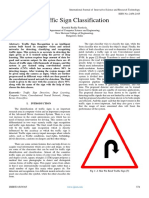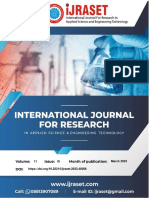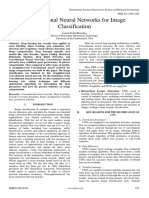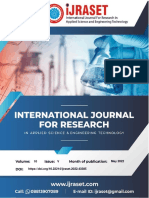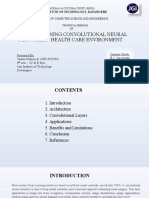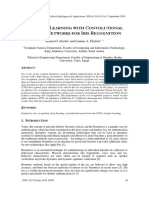Professional Documents
Culture Documents
Image Classification For Traffic Sign Recognition
Original Title
Copyright
Available Formats
Share this document
Did you find this document useful?
Is this content inappropriate?
Report this DocumentCopyright:
Available Formats
Image Classification For Traffic Sign Recognition
Copyright:
Available Formats
Volume 7, Issue 9, September – 2022 International Journal of Innovative Science and Research Technology
ISSN No:-2456-2165
Image Classification for Traffic Sign Recognition
Vedant Mahangade, Atharva Kulkarni, Siddhant Lodha, Atharva Awale,
Department of Information Technology,
Sinhgad College of Engineering,
Pune, India
Abstract:- Traffic signs are a crucial part of our road I. INTRODUCTION
environment. They provide crucial information,
sometimes compelling recommendations, to ensure that Most traffic accidents nowadays are caused by drivers'
driving behaviors are adjusted and that any currently unintentional disregard for traffic signs. With an automated
enforced traffic regulations are observed. With majority driving assistance system, we will be able to dramatically
of modern automobiles equipped with an automated reduce the number of traffic accidents and even prevent fatal
driving assistance systems a robust and efficient traffic accidents. The most prevalent of traffic sign recognizers
sign classifier would be considered a must. We propose a today, are image classification systems based on one of two
Traffic Sign Recognition system which follows a neural methods: one which contains a single algorithm like YOLO
network-based approach that uses YOLOv3 (You Only or R-CNN (Region-based Convolutional Neural Networks)
Look Once Version 3) as object detector rather than a for detection as well as classification and others which use
classifier followed by a CNN (Convolutional Neural traditional ML (Machine Learning) algorithms like HOG
Network) to classify traffic signs. This approach of (Histogram of Oriented Gradients) for object detection along
dividing the modules to compute single task turns out to with classification algorithms like CNN. Traditional ML
improve the system’s performance even with limited algorithms are not suitable for operations on
training thus providing a better platform for multidimensional inputs like images, whereas algorithms like
development of models to solve similar tasks. YOLO are specifically designed for tasks involving images.
YOLO in its own can detect as well as classify objects in an
Keywords:- YOLOv3, CNN, Traffic Sign, Image, image, however it is quite taxing in terms of training
Classification, Detection, Recognition. requirements. In order to obtain a comparatively better result
and performance than other classifiers, a YOLO model has to
be trained on thousands of images per class. Our proposed
system aims to overcome this drawback by dividing the
system into detector and classifier.
Fig. 1:- Functional Block Diagram
We use a YOLOv3 module only for detection of traffic large-scale datasets from ImageNet, by transferring its
signs, instead of training the model to classify traffic signs learned image representations and reuse them to the
across 43 different classes, we trained the model to detect classification task with limited training data. The main idea
traffic signs in images across 4 types based on color and is based on designing a method which reuses a part of training
shape. The detected sign is cropped and passed on to a layers of AlexNet. But this approach comes with limitations
separate 26 layered CNN model which classifies the traffic such as the model depends very much on the accuracy, fitting
sign across 43 different classes. With this approach we can and availability of pre-trained model.
ensure that accuracy and efficiency of detection as well as
classification is maintained even with limited training data. B. ‘Traffic Sign Detection and Recognition using a CNN
Ensemble’ by Aashrith Vennelakanti, Smriti Shreya,
II. LITERATURE REVIEW Resmi Rajendran, Debasis Sarkar, Deepak
Muddegowda, Phanish Hanagal
A. ‘Convolutional Neural Networks for image The System is divided into two phases: detection and
classification’ by Nadia Jmour, Sehla Zayen, Afef recognition. Detection is done based on shape and color of
Abdelkrim the traffic sign, followed by the sign validation. Once the
The proposed approach involves special case of transfer sign is detected, the portion of the image is cropped and is
learning on CNN variation called AlexNet applied on the feed to a CNN model for recognition. The use of CNN
IJISRT22SEP574 www.ijisrt.com 933
Volume 7, Issue 9, September – 2022 International Journal of Innovative Science and Research Technology
ISSN No:-2456-2165
ensembles increases the accuracy of recognition as each from the data set containing images with resolution of
CNN is trained separately over multiple epochs. However, 300×300 pixels with multiple objects to provide faster
since the detection is done on bases of shape and color of training time and faster detection results compared to other
traffic sign, the model would provide skewed results if types of neural networks. However, since the system was
image provided is distorted or partial. more focused on faster detection with least latency, the
results were less accurate and was more prone to false
C. ‘Traffic Signs Recognition in a mobile-based application outputs.
using TensorFlow and Transfer Learning technics’ by
Annamária R. Várkonyi-Kóczy, Abdallah Benhamida, III. PROPOSED SYSTEM
Miklos Kozlovszky
The proposed system uses a Single Shot MultiBox We built a Traffic Sign Recognition System which can
Detector (SSD) which is based on one single deep neural be split up into three functional modules, an object detector,
network to train the model on multiple objects per image. a preprocessor and a classifier. However, the entire system
The system uses TensorFlow with transfer learning contains more than just these three modules and the block
technique that makes it training process easier because of a wise representation can be seen in the given block diagram:
pre-trained CNN model. The input to the network is images
Fig. 2. Block Diagram
A. Object Detection
The object detector is basically a YOLOv3 model which is 106 Layer Convolutional Neural Network, based on the darknet
YOLOv3 model trained on COCO dataset for image classification for 80 classes.
Fig. 3:- YOLOv3 Architecture
The model used in our system is trained on GTSDB B. Preprocessing
(German Traffic Sign Detection Benchmark) dataset to Although we have filtered out the weaker detections
detect traffic signs in an image. It contains 3 output layer and there might be some ambiguity in the detected objects. We
on each of these 3 layers the output contains bounding box use non maximum suppression of the resultant bounding
co-ordinates and confidence on the scale of 0-1 for 4 boxes to exclude some of bounding boxes if their
following categories: Prohibited, Danger, Mandatory and confidences are lower than 0.3 or other bounding box is
Others present for same region with better confidence. For each
ROI (Region Of Interest) detected, we crop the image to
The model might detect irrelevant objects from the apply few transformations before feeding it to the classifier.
image, these objects are filtered out by setting the minimum
confidence as 0.5.
IJISRT22SEP574 www.ijisrt.com 934
Volume 7, Issue 9, September – 2022 International Journal of Innovative Science and Research Technology
ISSN No:-2456-2165
Fig. 4:- Pre-processor Operations
The cropped image is converted to grayscale so that function which is best suited for multi-class classification.
single intensity value for each pixel is retrieved instead to 3.
Then we apply Histogram equalization the grayscale image,
it increases the global contrast of the image to help
distinguish between a background and foreground. Now we
normalize the image based on intensity which changes the
range of pixel intensity values. Since the image is in
grayscale, only one channel needs to be normalized. Then
we apply dimensionality reduction by collapsing the image
into single channel and the processed image has dimensions Fig. 5:- 26-Layer CNN Architecture
as 32×32×1. The image is then forwarded to CNN classifier.
The input to the CNN is an image of 32X32X1
C. Classifier dimension. The filters move around this 2D matrix
The CNN classifier used is a 26 layered architecture producing feature maps by performing dot product. These
which includes convolutional, max pooling, batch are then feed to the dense or the fully connected layers of the
normalization, dense, dropout and flatten layers. The filter CNN to perform matrix vector multiplication for
size used is 3X3 and the number of filters in first layer is 16 classification and the last layer implements softmax function
which increases to 64 at the end of the feature extraction on the layer inputs to provide list of classes and its
segment. To prevent the over-fitting of the model we add probability. The one with highest probability is considered
dropout layer. There are 4 dense layer which perform the as the label for traffic sign.
classification task, the last of which uses softmax classifier
IV. PHASE SPLIT UP
Detection Dataset
A. Dataset Generation The GTSDB dataset used as detection dataset contains
Since the system uses two different models for two 900 images with traffic scenes spread over 43 classes which
different tasks, we trained each model on different datasets. significantly low for training a YOLOv3 model. The images
The YOLOv3 model which is used as an object detector has per class were very few and the distribution was overall
been trained on GTSDB dataset and the CNN model has uneven as the distribution graph below shows:
been trained on GTSRB (German Traffic Sign Recognition
Benchmark) dataset.
Fig. 6:- Detection Dataset Original Distribution
As mentioned, in our approach we used the YOLOv3 Prohibitory – Circular, White background, Red border
as a detector rather than a classifier, we divided the dataset Danger – Triangular, White background, Red border
across 4 categories instead of considering 43 classes. The 4 Mandatory – Circular, Blue background
categories were based on following characteristics of shape, Others – Remaining classes
background color and border color:
After the updated categorization of dataset, the
distribution was comparatively balanced:
IJISRT22SEP574 www.ijisrt.com 935
Volume 7, Issue 9, September – 2022 International Journal of Innovative Science and Research Technology
ISSN No:-2456-2165
YOLOv3 Training
The model used for detection was a YOLOv3 network
from darknet which was pretrained on COCO image dataset
for 80 classes. The model training parameters were changed
for training the model on the traffic sign dataset. We trained
the model for 8000 epochs using the darknet framework,
which provides efficient use of resources while training.
For training the model the parameters set were as
following:
Parameters Formulas and Values
Fig. 7:- Detection Dataset Categorized Distribution Batch 32 for training and 1 for testing
Subdivisions 16 for training and 1 for testing
The training dataset, by default had a ground truth file Max batches (no of classes * 2000) = 4*2000 =
in ‘.txt’ format containing image file names and their objects’ 8000
coordinates and the images were ‘.ppm’ files. We created a Steps 80% of max_batches, 90% of
python script to convert the entire dataset into YOLO max_batches
specific format, which is, images with ‘.jpg’ extension and a = 6400, 7200
text file for each image containing their object coordinates. Number of (no of classes + coordinates +
The dataset was then divided to form separate training and filters 1)*masks =
validation datasets with 5:1 train to validation ratio. (4+4+1)*3 = 27
Input Size 416, 416
Classification Dataset
Learning Rate 0.001
The CNN model used was trained on GTSRB dataset
Learning 0.0005
which contains 50000 cropped traffic sign images. The
Decay Rate
images per class although unevenly distributed, were
Table 1:- YOLO model Training Parameters
significantly enough for classification of traffic signs. The
distribution of number of images by class was as below:
CNN Training
Two CNN models were taken into consideration, a 10-
layer neural network and one 26-layer network. Each trained
several times over different hyper parameter to find the best
suited model with better performance. Both the models
where trained for different number of epochs ranging from
10 to 30, with batch size varying from 32 to 128 and on
different learning rates as 0.001, 0.0008, 0.0005 and 0.0001.
The models were evaluated on basis of Test accuracy
and test loss. For both the architectures, the models with
highest test accuracy and considerably low test loss was
considered for comparison. The table below shows the
hyper-parameters and performance metrics of best models
obtained from two architectures:
Model Hyper-parameters Metrics
Fig. 8:- Classification Dataset Distribution Learning Batch Steps Epochs Test Test
Rate Size per Loss Accuracy
65% of the images where used for training, 25 for epoch
validation and 10% for testing. These images where in
pickled format with size of 32×32 pixels and were utilized Model 0.0005 64 544 20 0.193 0.926
for training and validation as it is. 1
Model 0.0001 32 1088 30 0.189 0.959
B. Training 2
Training AI models for image-based operations is a
heavily resource intensive task and require high processing Table 2:- CNN model Training Parameters
power to efficient training. Both the models were trained on
Google Colab, a cloud based Jupyter Notebook environment The model 2 loss is less than model 1, and the loss
which allows to run python scripts on hosted runtime. These curve over validation set is also comparatively smooth. For
models where trained using NVIDIA Tesla K80 GPU hosted accuracy the model 1 performs better with slightly high
on google colab platform. accuracy than model 2 but the accuracy curve is not as
smooth as that for model 2, which means that the model 1 is
IJISRT22SEP574 www.ijisrt.com 936
Volume 7, Issue 9, September – 2022 International Journal of Innovative Science and Research Technology
ISSN No:-2456-2165
slightly overfit. Considering these factors, we decided to use 13 therefore the model used was best among 20, whose
model 2 as our final model for classification. parameters were empirically determined. The model’s test
loss score is 0.1897 and the accuracy score is 0.9597. The
C. UI development two images below depict the Loss and Accuracy curve of the
For development of UI we used PyQT5 which is a 26-layered CNN model used in the system.
python GUI toolkit. PyQT5 offers cache functionality
therefore the app launches quicker. The UI components and
the system modules are kept separate and are linked together
with a loader file. User can run the loader file to use the
classifier, upload the image, click on Classify button and the
result image with bounding boxes as well the output on
output-panel is displayed. A copy of result image is stored
in the results folder with the text file containing the list of
objects.
V. RESULTS
A. Object Detector Evaluation
The YOLO model was evaluated based on mAP (Mean
Average Precision) with IoU (Intersection over Union) of 50%
or in short mAP@50. The final model used for the system Fig. 10:- Loss Curve
has a mAP@50 value of 99.135%. For every 1000 epochs
while training the mAP was calculated and the model was
saved. The model with highest mAP value was taken into
consideration. The variation of mAP over 8000 epochs can
be seen in the graph below.
Fig. 11:- Accuracy Curve
For 1st classification the model takes 0.524 seconds on
average and for rest of the classification around 0.096
seconds. For the 1st classification the model takes
Fig. 9:- mAP over Epochs Curve comparatively more time than that for others.
The mAP is calculated by taking mean of average C. Results
precision of the recognition of 4 classes which are given Since two different models with different nature and
below: objectives are used for detection and classification, a
combined metric to evaluate the those two at the same time
cannot be established. Hence time was the only common
Prohibitory = 100.00%
factor which can be used to test the entire system’s
Mandatory = 96.98%
performance.
Danger = 100.00%
Other = 99.56% The average computational time calculated for 111
images for entire process of loading the image, detecting
These values are obtained by testing the model on 111 objects, preprocessing the cropped images, classifying the
images of the test set. On average the model takes 0.88 traffic signs, putting labels, saving the image and displaying
seconds to detect signs and can detect up to 5 signs and it comes out to be around 2.579 seconds.
sometimes more depending upon the quality of image.
The two images below are the snapshots of one of test-
B. Classifier Evaluation cases. The input image provided to the system containing
The 26-layered CNN used has been tested on test more than 1 traffic sign and the output displayed by system.
dataset containing 12630 images with loss and accuracy as
metrics. The best model was chosen from two architectures
1st with 7 training parameter variations and the second with
IJISRT22SEP574 www.ijisrt.com 937
Volume 7, Issue 9, September – 2022 International Journal of Innovative Science and Research Technology
ISSN No:-2456-2165
REFERENCES
[1]. A. Avramović, D. Tabernik, D. Skočaj, “Real-time
Large-Scale Traffic Sign Detection”, Symposium on
Neural Networks and Applications, Serbia,2018.5. S.
Indolia, A. K. Goswami, S. P. Mishra, P. Asopa,
“Conceptual Understanding of CNN a Deep Learning
Approach.” International Conference on
Computational Intelligence and Data Science,2018.
[2]. Aashrith Vennelakanti, Smriti Shreya, Resmi
Rajendran, Debasis Sarkar, Deepak Muddegowda,
Phanish Hanagal, “Traffic Sign Detection and
Recognition using a CNN Ensemble”. International
Conference on Computational Intelligence and Data
Science, 2018.
[3]. Abdallah Benhamida, Annamária R. Várkonyi-Kóczy,
Fig. 12:- Input Image Miklos Kozlovszky, “Traffic Signs Recognition in a
mobile-based application using TensorFlow and
Transfer Learning technics”, SoSE 2020 • IEEE 15th
International Conference of System of Systems
Engineering • June 2-4, 2020 Budapest, Hungary
[4]. Branislav Novak, Velibor Ilić, Bogdan Pavković,
“YOLOv3 Algorithm with additional convolutional
neural network trained for traffic sign recognition”.
2020 Zooming Innovation in Consumer Technologies
Conference (ZINC)
[5]. N Jmour, S. Zayen, A. Abdelkrim, “Convolutional
Neural Networks for image classification.”
International Conference on Robots & Intelligent
System, 2018.
[6]. R. C. Gonzalez, “Deep Convolutional Neural
Networks” IEEE Signal Processing Magazine (79-
87),2018 15. Erhan, D., Szegedy, C., Toshev, A., and
Anguelov, D. (2014). “Scalable object detection using
Fig. 13:- Output Image with Classificaiton Label deep neural networks,” in Computer Vision and
Pattern Recognition Frontiers in Robotics and AI
The system took exactly 1.96382 seconds to detect and www.frontiersin.org November 2015
classify 3 traffic signs from the image correctly. The [7]. Wang Canyong, “Research and Application of Traffic
maximum number of traffic sign detected in an image were Sign Detection and Recognition Based Deep
11 and were correctly classified. Learning.” International Conference on Robots &
Intelligent System,2018.
VI. CONCLUSION
The traffic sign classifier gives comparatively accurate
detection and classification in comparatively short time. The
result shows that the system is robust and efficient. The
system has been successfully implemented with the desired
results obtained given that the modules were trained on
limited resources.
The system performance is well above the benchmark
set by studying the previous methodology. There are various
ways new models can be created using this proposed system,
for example training the yolo model with Indian traffic
scenes with categorized classes and training the CNN with
cropped images of expanded classes will help create a
system which can be implemented for detecting Indian road
traffic signs. Even a video can be given as input by writing
a code which divides the video into frames and feeds to the
system, the same video can be replaced with a real time feed
from camera to provide real-time traffic sign recognition.
IJISRT22SEP574 www.ijisrt.com 938
You might also like
- Traffic Sign ClassificationDocument4 pagesTraffic Sign ClassificationInternational Journal of Innovative Science and Research TechnologyNo ratings yet
- Telfor Paper 4172Document5 pagesTelfor Paper 4172faraliveNo ratings yet
- CNN Traffic Sign Recognition ModelDocument16 pagesCNN Traffic Sign Recognition Modelbt5112 KareenaNo ratings yet
- CNN object detection helps blind with real-time scene analysisDocument7 pagesCNN object detection helps blind with real-time scene analysisHarsh ModiNo ratings yet
- Title - Traffic Sign Detection Using Convolutional Neural NetworkDocument15 pagesTitle - Traffic Sign Detection Using Convolutional Neural NetworkPranav TandonNo ratings yet
- (IJCST-V10I5P12) :mrs J Sarada, P Priya BharathiDocument6 pages(IJCST-V10I5P12) :mrs J Sarada, P Priya BharathiEighthSenseGroupNo ratings yet
- Age and Gender With Mask ReportDocument15 pagesAge and Gender With Mask Reportsuryavamsi kakaraNo ratings yet
- Simulation: Deep learning object recognition for autonomous vehiclesDocument11 pagesSimulation: Deep learning object recognition for autonomous vehiclesDaryAntoNo ratings yet
- Pedestrian Detection System Based On Deep LearningDocument5 pagesPedestrian Detection System Based On Deep LearningInternational Journal of Advances in Applied Sciences (IJAAS)No ratings yet
- A_Traffic_Sign_Recognition_Method_Under_Complex_Illumination_ConditionsDocument12 pagesA_Traffic_Sign_Recognition_Method_Under_Complex_Illumination_ConditionsEZHILMANI SNo ratings yet
- ProjectProposal TresMariasDocument3 pagesProjectProposal TresMariasjohnvincent.cabugnasonNo ratings yet
- Applsci 13 12977Document21 pagesApplsci 13 12977gopineedivigneshNo ratings yet
- 50 Most important CNN interview QuestionsDocument18 pages50 Most important CNN interview QuestionsDeepak KumarNo ratings yet
- Learning Hierarchical Features For Scene LabelingDocument15 pagesLearning Hierarchical Features For Scene LabelingkiltzNo ratings yet
- Deep Learning Based Object Detection and Recognition Framework For The Visually-ImpairedDocument5 pagesDeep Learning Based Object Detection and Recognition Framework For The Visually-ImpairedAbdunabi MuhamadievNo ratings yet
- (IJETA-V10I1P1) :M.Thachayani, G.RubavaniDocument3 pages(IJETA-V10I1P1) :M.Thachayani, G.RubavaniIJETA - EighthSenseGroupNo ratings yet
- Vehicle Detection For Accident PreventionDocument7 pagesVehicle Detection For Accident PreventionIJRASETPublicationsNo ratings yet
- Qian 2015Document10 pagesQian 2015FrankNo ratings yet
- Traffic Sign Detection Using Convolutional Neural Network: TitleDocument15 pagesTraffic Sign Detection Using Convolutional Neural Network: TitlePranav TandonNo ratings yet
- Mask R-CNN and YOLO for Vehicle License Plate IdentificationDocument9 pagesMask R-CNN and YOLO for Vehicle License Plate IdentificationBanushaCNo ratings yet
- Embedded Computer Vision System Detects Traffic ObjectsDocument20 pagesEmbedded Computer Vision System Detects Traffic ObjectseviteNo ratings yet
- Improved YOLOv3 helmet detection on unbalanced dataDocument5 pagesImproved YOLOv3 helmet detection on unbalanced dataSurya PeriasamyNo ratings yet
- Prakash2019 - Face RecognitionDocument4 pagesPrakash2019 - Face Recognitioneshwari2000No ratings yet
- 2 PDFDocument13 pages2 PDFHouda TàNo ratings yet
- Research PaperDocument7 pagesResearch PaperAhmed BenchekrounNo ratings yet
- Deep LearningDocument9 pagesDeep LearningAnonymous xMYE0TiNBcNo ratings yet
- Handwritten Letter Recognition Using Artificial Intelligence'Document9 pagesHandwritten Letter Recognition Using Artificial Intelligence'IJRASETPublicationsNo ratings yet
- SC-YOLO A Object Detection Model For Small Traffic SignsDocument11 pagesSC-YOLO A Object Detection Model For Small Traffic SignsthewildmusicworldNo ratings yet
- Object Detection Using YOLODocument9 pagesObject Detection Using YOLOIJRASETPublicationsNo ratings yet
- 1.convolutional Neural Networks For Image ClassificationDocument11 pages1.convolutional Neural Networks For Image ClassificationMuhammad ShoaibNo ratings yet
- Deep Learning Based Obstacle Detection and Classification With Portable Uncalibrated Patterned LightDocument10 pagesDeep Learning Based Obstacle Detection and Classification With Portable Uncalibrated Patterned LightKARTHICK ANo ratings yet
- Convolutional Neural Networks For Image ClassificationDocument5 pagesConvolutional Neural Networks For Image ClassificationInternational Journal of Innovative Science and Research TechnologyNo ratings yet
- Image Classification Using Deep Learning and TensorflowDocument7 pagesImage Classification Using Deep Learning and TensorflowIJRASETPublicationsNo ratings yet
- Traffic Sign DetectionDocument5 pagesTraffic Sign DetectionSameer SinghNo ratings yet
- Multiple Object Tracking For Video Analysis and Surveillance A Literature SurveyDocument10 pagesMultiple Object Tracking For Video Analysis and Surveillance A Literature SurveyInternational Journal of Innovative Science and Research TechnologyNo ratings yet
- TS PPT (Autosaved)Document16 pagesTS PPT (Autosaved)Vasiha Fathima RNo ratings yet
- 003 Hybrid Deep Learning-Gaussian Process Network For Pedestrian Lane Detection in Unstructured ScenesDocument15 pages003 Hybrid Deep Learning-Gaussian Process Network For Pedestrian Lane Detection in Unstructured ScenesPratik TakudageNo ratings yet
- Remotesensing 13 00089 v2Document23 pagesRemotesensing 13 00089 v2Varun GoradiaNo ratings yet
- Custom Object Detection and Analysis in Real Time YOLOv4Document11 pagesCustom Object Detection and Analysis in Real Time YOLOv4IJRASETPublicationsNo ratings yet
- Traffic Sign Identification Using Modified LeNet-5 CNNDocument9 pagesTraffic Sign Identification Using Modified LeNet-5 CNNIJRASETPublicationsNo ratings yet
- Real Time Object Detection in Surveillance Cameras With 2xjeq74wamDocument8 pagesReal Time Object Detection in Surveillance Cameras With 2xjeq74wamMark Angelou PedNo ratings yet
- Object Detection Method Based On YOLOv3 Using - Deep Learning NetworksDocument4 pagesObject Detection Method Based On YOLOv3 Using - Deep Learning NetworksLauraCamilaDuqueNo ratings yet
- Final Project Paper AkashDocument5 pagesFinal Project Paper AkashAkash SridharanNo ratings yet
- A Deep Learning Convolutional Neural Network in Health Care EnvironmentDocument17 pagesA Deep Learning Convolutional Neural Network in Health Care EnvironmentVasiha Fathima RNo ratings yet
- Motion Blur Detection and Removal in ImagesDocument3 pagesMotion Blur Detection and Removal in ImagesInternational Journal of Innovative Science and Research TechnologyNo ratings yet
- Machinelearning Unit 4Document6 pagesMachinelearning Unit 4yogeshNo ratings yet
- Neural Network Based Road Sign RecognitionDocument8 pagesNeural Network Based Road Sign RecognitionIman Sohail FastNUNo ratings yet
- Arxiv Preprint 1804.10428Document7 pagesArxiv Preprint 1804.10428Ceren ÖzcanNo ratings yet
- CR-YOLOv8 Multiscale Object Detection in Traffic Sign ImagesDocument10 pagesCR-YOLOv8 Multiscale Object Detection in Traffic Sign ImagesThe RoobanNo ratings yet
- Anchor-Based Vs Anchor-Free ObjectDocument8 pagesAnchor-Based Vs Anchor-Free Objectsobuz visualNo ratings yet
- Face Verification Based On Convolutional Neural Network and Deep LearningDocument5 pagesFace Verification Based On Convolutional Neural Network and Deep LearningSilicon DaltonNo ratings yet
- Modified YOLO Module For Efficient Object Tracking in A VideoDocument10 pagesModified YOLO Module For Efficient Object Tracking in A VideoBennish MNo ratings yet
- Survey On Different Object Detection and Segmentation MethodsDocument4 pagesSurvey On Different Object Detection and Segmentation MethodsInternational Journal of Innovative Science and Research TechnologyNo ratings yet
- Review of Violence Detection System.Document4 pagesReview of Violence Detection System.Vishwajit DandageNo ratings yet
- Traffic Sign Detection For Autonomous VehicleApplicationDocument5 pagesTraffic Sign Detection For Autonomous VehicleApplicationInternational Journal of Innovative Science and Research TechnologyNo ratings yet
- Transfer Learning With Convolutional Neural Networks For Iris RecognitionDocument18 pagesTransfer Learning With Convolutional Neural Networks For Iris RecognitionAdam HansenNo ratings yet
- 2017 Ieee Tits KuangDocument10 pages2017 Ieee Tits KuangWafa BenzaouiNo ratings yet
- Image Classification Using Small Convolutional Neural NetworkDocument5 pagesImage Classification Using Small Convolutional Neural NetworkKompruch BenjaputharakNo ratings yet
- Algorithms 14 00257 v2Document14 pagesAlgorithms 14 00257 v2Selcuk SelcukNo ratings yet
- Compact and Wearable Ventilator System for Enhanced Patient CareDocument4 pagesCompact and Wearable Ventilator System for Enhanced Patient CareInternational Journal of Innovative Science and Research TechnologyNo ratings yet
- Insights into Nipah Virus: A Review of Epidemiology, Pathogenesis, and Therapeutic AdvancesDocument8 pagesInsights into Nipah Virus: A Review of Epidemiology, Pathogenesis, and Therapeutic AdvancesInternational Journal of Innovative Science and Research TechnologyNo ratings yet
- Implications of Adnexal Invasions in Primary Extramammary Paget’s Disease: A Systematic ReviewDocument6 pagesImplications of Adnexal Invasions in Primary Extramammary Paget’s Disease: A Systematic ReviewInternational Journal of Innovative Science and Research TechnologyNo ratings yet
- Smart Cities: Boosting Economic Growth through Innovation and EfficiencyDocument19 pagesSmart Cities: Boosting Economic Growth through Innovation and EfficiencyInternational Journal of Innovative Science and Research TechnologyNo ratings yet
- Air Quality Index Prediction using Bi-LSTMDocument8 pagesAir Quality Index Prediction using Bi-LSTMInternational Journal of Innovative Science and Research TechnologyNo ratings yet
- An Analysis on Mental Health Issues among IndividualsDocument6 pagesAn Analysis on Mental Health Issues among IndividualsInternational Journal of Innovative Science and Research TechnologyNo ratings yet
- The Making of Object Recognition Eyeglasses for the Visually Impaired using Image AIDocument6 pagesThe Making of Object Recognition Eyeglasses for the Visually Impaired using Image AIInternational Journal of Innovative Science and Research TechnologyNo ratings yet
- Harnessing Open Innovation for Translating Global Languages into Indian LanuagesDocument7 pagesHarnessing Open Innovation for Translating Global Languages into Indian LanuagesInternational Journal of Innovative Science and Research TechnologyNo ratings yet
- Parkinson’s Detection Using Voice Features and Spiral DrawingsDocument5 pagesParkinson’s Detection Using Voice Features and Spiral DrawingsInternational Journal of Innovative Science and Research TechnologyNo ratings yet
- Dense Wavelength Division Multiplexing (DWDM) in IT Networks: A Leap Beyond Synchronous Digital Hierarchy (SDH)Document2 pagesDense Wavelength Division Multiplexing (DWDM) in IT Networks: A Leap Beyond Synchronous Digital Hierarchy (SDH)International Journal of Innovative Science and Research TechnologyNo ratings yet
- Investigating Factors Influencing Employee Absenteeism: A Case Study of Secondary Schools in MuscatDocument16 pagesInvestigating Factors Influencing Employee Absenteeism: A Case Study of Secondary Schools in MuscatInternational Journal of Innovative Science and Research TechnologyNo ratings yet
- Exploring the Molecular Docking Interactions between the Polyherbal Formulation Ibadhychooranam and Human Aldose Reductase Enzyme as a Novel Approach for Investigating its Potential Efficacy in Management of CataractDocument7 pagesExploring the Molecular Docking Interactions between the Polyherbal Formulation Ibadhychooranam and Human Aldose Reductase Enzyme as a Novel Approach for Investigating its Potential Efficacy in Management of CataractInternational Journal of Innovative Science and Research TechnologyNo ratings yet
- Comparatively Design and Analyze Elevated Rectangular Water Reservoir with and without Bracing for Different Stagging HeightDocument4 pagesComparatively Design and Analyze Elevated Rectangular Water Reservoir with and without Bracing for Different Stagging HeightInternational Journal of Innovative Science and Research TechnologyNo ratings yet
- The Relationship between Teacher Reflective Practice and Students Engagement in the Public Elementary SchoolDocument31 pagesThe Relationship between Teacher Reflective Practice and Students Engagement in the Public Elementary SchoolInternational Journal of Innovative Science and Research TechnologyNo ratings yet
- Diabetic Retinopathy Stage Detection Using CNN and Inception V3Document9 pagesDiabetic Retinopathy Stage Detection Using CNN and Inception V3International Journal of Innovative Science and Research TechnologyNo ratings yet
- The Utilization of Date Palm (Phoenix dactylifera) Leaf Fiber as a Main Component in Making an Improvised Water FilterDocument11 pagesThe Utilization of Date Palm (Phoenix dactylifera) Leaf Fiber as a Main Component in Making an Improvised Water FilterInternational Journal of Innovative Science and Research TechnologyNo ratings yet
- Advancing Healthcare Predictions: Harnessing Machine Learning for Accurate Health Index PrognosisDocument8 pagesAdvancing Healthcare Predictions: Harnessing Machine Learning for Accurate Health Index PrognosisInternational Journal of Innovative Science and Research TechnologyNo ratings yet
- Auto Encoder Driven Hybrid Pipelines for Image Deblurring using NAFNETDocument6 pagesAuto Encoder Driven Hybrid Pipelines for Image Deblurring using NAFNETInternational Journal of Innovative Science and Research TechnologyNo ratings yet
- Formulation and Evaluation of Poly Herbal Body ScrubDocument6 pagesFormulation and Evaluation of Poly Herbal Body ScrubInternational Journal of Innovative Science and Research TechnologyNo ratings yet
- Electro-Optics Properties of Intact Cocoa Beans based on Near Infrared TechnologyDocument7 pagesElectro-Optics Properties of Intact Cocoa Beans based on Near Infrared TechnologyInternational Journal of Innovative Science and Research TechnologyNo ratings yet
- Terracing as an Old-Style Scheme of Soil Water Preservation in Djingliya-Mandara Mountains- CameroonDocument14 pagesTerracing as an Old-Style Scheme of Soil Water Preservation in Djingliya-Mandara Mountains- CameroonInternational Journal of Innovative Science and Research TechnologyNo ratings yet
- Explorning the Role of Machine Learning in Enhancing Cloud SecurityDocument5 pagesExplorning the Role of Machine Learning in Enhancing Cloud SecurityInternational Journal of Innovative Science and Research TechnologyNo ratings yet
- The Impact of Digital Marketing Dimensions on Customer SatisfactionDocument6 pagesThe Impact of Digital Marketing Dimensions on Customer SatisfactionInternational Journal of Innovative Science and Research TechnologyNo ratings yet
- Navigating Digitalization: AHP Insights for SMEs' Strategic TransformationDocument11 pagesNavigating Digitalization: AHP Insights for SMEs' Strategic TransformationInternational Journal of Innovative Science and Research Technology100% (1)
- A Survey of the Plastic Waste used in Paving BlocksDocument4 pagesA Survey of the Plastic Waste used in Paving BlocksInternational Journal of Innovative Science and Research TechnologyNo ratings yet
- Design, Development and Evaluation of Methi-Shikakai Herbal ShampooDocument8 pagesDesign, Development and Evaluation of Methi-Shikakai Herbal ShampooInternational Journal of Innovative Science and Research Technology100% (3)
- A Review: Pink Eye Outbreak in IndiaDocument3 pagesA Review: Pink Eye Outbreak in IndiaInternational Journal of Innovative Science and Research TechnologyNo ratings yet
- Cyberbullying: Legal and Ethical Implications, Challenges and Opportunities for Policy DevelopmentDocument7 pagesCyberbullying: Legal and Ethical Implications, Challenges and Opportunities for Policy DevelopmentInternational Journal of Innovative Science and Research TechnologyNo ratings yet
- Hepatic Portovenous Gas in a Young MaleDocument2 pagesHepatic Portovenous Gas in a Young MaleInternational Journal of Innovative Science and Research TechnologyNo ratings yet
- Automatic Power Factor ControllerDocument4 pagesAutomatic Power Factor ControllerInternational Journal of Innovative Science and Research TechnologyNo ratings yet
- Digital Marketing Learning Material PDFDocument14 pagesDigital Marketing Learning Material PDFAvishek TarafderNo ratings yet
- Dell Inspiron M102Z - Compal LA-7161P PLM00Document43 pagesDell Inspiron M102Z - Compal LA-7161P PLM00Toni SetyawanNo ratings yet
- IP Camera iSmartViewPro Manual (EN Version) PDFDocument29 pagesIP Camera iSmartViewPro Manual (EN Version) PDFdummy damnNo ratings yet
- CYBER CRIME STATS AND TRENDSDocument13 pagesCYBER CRIME STATS AND TRENDSSamuel ThomasNo ratings yet
- Computer Architecture and Assembly Language Programming - CS401 Fall 2007 Assignment 01 SolutionDocument3 pagesComputer Architecture and Assembly Language Programming - CS401 Fall 2007 Assignment 01 SolutionNaqvi The Boy from HafizabadNo ratings yet
- Seo PackagesDocument11 pagesSeo PackagesKareem GulfNo ratings yet
- Bluetooth Module Datasheet: Model: TS64215Document11 pagesBluetooth Module Datasheet: Model: TS64215StefanoViganóNo ratings yet
- Microcontroller Lab Manual for Electronics StudentsDocument54 pagesMicrocontroller Lab Manual for Electronics StudentsParthaSarathyNo ratings yet
- Herbal LifeDocument2 pagesHerbal LifeSonal ChoudharyNo ratings yet
- Introduction to Debugging and Profiling Tools on Cray SystemsDocument21 pagesIntroduction to Debugging and Profiling Tools on Cray Systemsluis900000No ratings yet
- 1 V 2 B 3 V 4 B 5 V 6 1.4 7 1,2,3 8 1,2,3,4,5 9 1,3,4,5 10 1.5 11 2,3,4 12 1,3,4 13 A 14 A 15 1.3 16 C 17 3.4 18 CDocument10 pages1 V 2 B 3 V 4 B 5 V 6 1.4 7 1,2,3 8 1,2,3,4,5 9 1,3,4,5 10 1.5 11 2,3,4 12 1,3,4 13 A 14 A 15 1.3 16 C 17 3.4 18 CJorge Henriquez FuentealbaNo ratings yet
- Roadmap DSADocument5 pagesRoadmap DSAAnanya SinhaNo ratings yet
- 051796F0.sch-1 - Thu Dec 15 11:09:57 2005Document25 pages051796F0.sch-1 - Thu Dec 15 11:09:57 2005Aconatic tvhomeNo ratings yet
- PMP450x ReleaseNotes16.1.1.1Document35 pagesPMP450x ReleaseNotes16.1.1.1john villamilNo ratings yet
- Object Interaction - Sequence Diagrams: Based On Chapter 9 Bennett, Mcrobb and FarmerDocument38 pagesObject Interaction - Sequence Diagrams: Based On Chapter 9 Bennett, Mcrobb and FarmerAmtul RahmanNo ratings yet
- Binary Cloning in Oracle 12cDocument3 pagesBinary Cloning in Oracle 12cLiloNo ratings yet
- Etap14-1 Readme PDFDocument138 pagesEtap14-1 Readme PDFNguyen Quang SangNo ratings yet
- 18CS752 Python CodeDocument34 pages18CS752 Python CodeAdarsh ReddyNo ratings yet
- TOR GIS Training Medecins - Du MondeDocument2 pagesTOR GIS Training Medecins - Du Mondelive streamingNo ratings yet
- Project ListDocument66 pagesProject Listapi-278127585No ratings yet
- Hyd 12 CS QP PB1-PDocument10 pagesHyd 12 CS QP PB1-PSUMIT KUMARNo ratings yet
- ETAsoft Forex GeneratorDocument106 pagesETAsoft Forex GeneratorJulius Wegeta100% (3)
- ODIS Service Quick Guide for UMB_v1Document26 pagesODIS Service Quick Guide for UMB_v1marusv100% (1)
- Intelligent Platform Management Interface Implementer's Guide Draft-Version 0.7Document94 pagesIntelligent Platform Management Interface Implementer's Guide Draft-Version 0.7alexchuah100% (1)
- How To Create Infographics in PowerPoint by HubSpotDocument10 pagesHow To Create Infographics in PowerPoint by HubSpotAkshay SetlurNo ratings yet
- Ti50a01a10-02en 001Document104 pagesTi50a01a10-02en 001Dhirender DagarNo ratings yet
- The Top 21 Python Trading Tools For 2020 - Analyzing AlphaDocument28 pagesThe Top 21 Python Trading Tools For 2020 - Analyzing AlphaJose Carlos Sierra CiudadNo ratings yet
- Moldflow Adviser 2018 BrochureDocument3 pagesMoldflow Adviser 2018 BrochureCharlesNo ratings yet
- Arsal Javed 19-Arid-2843 Bsit4th Web Mid PaperDocument10 pagesArsal Javed 19-Arid-2843 Bsit4th Web Mid PaperArsal Javed ButtNo ratings yet
- ITMS 6xmigration GuideDocument199 pagesITMS 6xmigration Guidekeithdavid33No ratings yet
